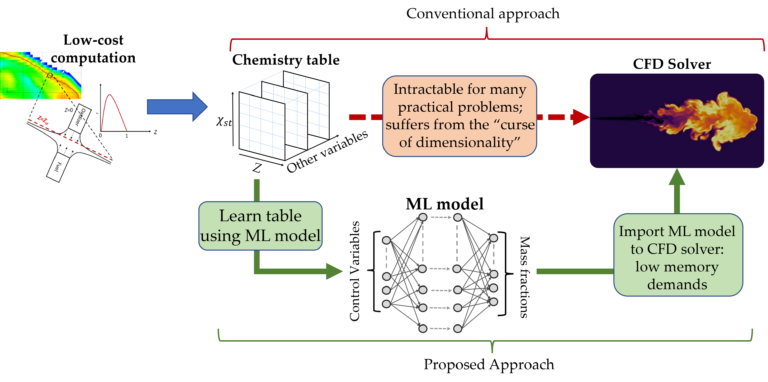Research
Reduced-order modeling of turbulent reacting flows

Improved computational modeling tools for turbulent combustion are critical, since it is the primary mode of energy conversion in most power generation and propulsion devices. Turbulent combustion, however, is highly complex and challenging to model, due to the simultaneous occurrence and interactions of a turbulent flow field and non-linear chemical kinetics. While early simulation tools involved global chemical mechanisms with one-step chemistry, in the past decade, the field has been moving towards more realistic descriptions of chemistry. These realistic descriptions often require utilizing reduced, and sometimes, detailed chemical kinetics, which involve the transport of several chemical species. Capturing the behavior of such a large number of reactive scalars within a turbulent flow field is very compute-intensive, and this has led to the development of model-order reduction (MOR) techniques that reduce the number of reactive scalars by projecting the chemical state-space to a low-dimensional subspace, defined by principal components. These approaches suffer from poor generality, lack of interpretability, and the absence of methods to estimate errors during simulations. This work aims to fill critical gaps relating to the above challenges by creating novel projection mechanisms that exploit local structures to create models that are more generalizable and accurate than current approaches. The proposed reduced-order modeling approach will lead to realistic combustion simulations that are 2–3 orders of magnitude faster than simulations involving the full set of reactive scalars, while maintaining accuracy.
Optimization using cooperative swarms
The principle of swarm intelligence refers to relatively simple agents or organisms collectively performing complex tasks or causing global patterns to emerge. Examples of these can be seen in nature including, foraging of ants for food, flocking/schooling in birds and fish, and bee colonies seeking new homes. The goal of this project is to discover policies for swarm behavior using reinforcement learning. The main application of interest is to discover efficient optimizers that can be used for simulation-driven design optimization, material discovery, and process-parameter optimization in manufacturing manufacturing processes.
Multi-fidelity machine learning models for SAF functional relationships

Biomass-derived Sustainable Aviation Fuels (SAF) offer a path to decarbonize emissions, reduce harmful pollution, and impact climate change. Globally, there is a growing effort to adopt SAF for commercial aviation due to sustained growth in aviation demand, lack of short to medium-term technological alternatives, and global competition for finite oil supplies as affected by market volatility and supply-chain issues. A key advantage of SAF is its ability to be synthesized from a large variety of feedstock including agricultural waste and forestry residue. A critical hurdle, however, is the time and expense to ensure candidate fuels, particularly from emerging feedstock, can pass through the ASTM D4054 aviation fuel certification process. This research focuses on the development of an improved pre-screening strategy for candidate SAF, leveraging multi-fidelity machine learning (ML) algorithms to develop functional relationships connecting fuel properties to combustor FOM relevant to aviation engines. The pre-screening strategy developed through this research will incorporate combustor metric sensitivities lacking in current approaches, facilitate model-based tuning of fuel synthesis steps, and pave the way for eventual implementation of engine-fuel co-optimization strategies. The proposed functional relationships representing merit functions for combustor metrics will be established by research tasks conducted by an interdisciplinary team from Louisiana State University (LSU) with critical partnerships to leverage specific expertise, instruments, and modeling capabilities of DOE National Laboratories, including the National Renewable Energy Laboratory (NREL) and Argonne National Laboratory (ANL).
Reduced representation of chemical kinetics

When performing computational fluid dynamics (CFD) simulations of reacting flows, capturing the effects of chemical kinetics remains the main bottleneck. In recent years a number of studies that employ the use of machine learning, particularly artificial neural networks, have emerged, showing promise. However, neural networks are often inaccurate for multiscale predictive modeling, as required when building models for the chemical source terms, prompting the use of scaling techniques such as logarithmic transformations to improve predictions at the smaller scales. Despite these remedies, neural network-based chemical source terms often lead to inaccurate and unstable solutions of the species’ mass fractions when coupled with an ordinary differential equation (ODE) solver and integrated in time. Our research group is developing a probabilistic machine framework that provides superior stability/accurate over conventional machine learning approaches while providing improved runtimes compared to physics-based models on modern architecture.
Data-driven closure of physics-derived turbulent combustion manifolds

Turbulent combustion is a highly complex process that involves the multiscale evolution of a large number of chemical scalars, leading to extreme computational costs. In response to this, physically derived reduced-order models based on simplifying assumptions have been developed, and these often involve storing the evolution of the chemical species in tables for lookup during numerical simulations. While such approaches offer a viable strategy for reducing computational costs, they suffer from what has been referred to as the “curse of dimensionality,” wherein the size of the chemistry tables and the associated interpolation times increase exponentially with the number of control variables. In response to these issues, the proposed research aims to develop a machine learning framework for turbulent combustion models that is (1) adaptive and (2) consistent with the underlying combustion physics. An approach that combines several simple data-based models to form a complex model that is accurate over wide-ranging conditions will be developed. The proposed framework will also incorporate strategies for efficiently learning combustion-type problems where several dependent variables are often encountered, and a method to embed physics in machine learning-based tabulation of combustion. The developed data-based and computational tools will be validated by applying them to flamelet-based simulations of practical combustion problems with increasing complexity, with the goal of demonstrating (1) predictiveness, (2) memory efficiency, and (3) computational speed.